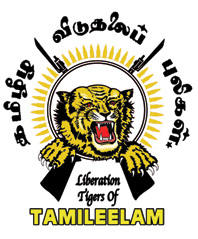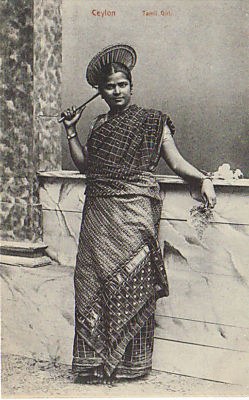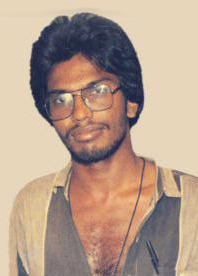Related Research Articles

The Liberation Tigers of Tamil Eelam was a Tamil militant organization that was based in northeastern Sri Lanka. The LTTE fought to create an independent Tamil state called Tamil Eelam in the north-east of the island, due to the continuous discrimination and violent persecution against Sri Lankan Tamils by the Sinhalese dominated Sri Lankan Government.

The Sri Lankan Civil War was a civil war fought in Sri Lanka from 1983 to 2009. Beginning on 23 July 1983, there was an intermittent insurgency against the government by the Velupillai Prabhakaran-led Liberation Tigers of Tamil Eelam. The LTTE fought to create an independent Tamil state called Tamil Eelam in the north-east of the island, due to the continuous discrimination and violent persecution against Sri Lankan Tamils by the Sinhalese dominated Sri Lankan Government.

Velupillai Prabhakaran (listen ; Tamil: வேலுப்பிள்ளை பிரபாகரன்; Tamil pronunciation: [ˈʋeːlɯpːiɭːaɪ pɾaˈbaːhaɾan], was a Sri Lankan Tamil guerrilla and the founder and leader of the Liberation Tigers of Tamil Eelam, a militant organization that sought to create an independent Tamil state in the north and east of Sri Lanka, due to the oppression of Sri Lankan Tamils by the Sri Lankan Government. The LTTE waged war in Sri Lanka for more than 25 years, to create an independent state for the Sri Lankan Tamil people.
The Indo-Sri Lanka Peace Accord was an accord signed in Colombo on 29 July 1987, between Indian Prime Minister Rajiv Gandhi and Sri Lankan President J. R. Jayewardene. The accord was expected to resolve the Sri Lankan Civil War by enabling the thirteenth Amendment to the Constitution of Sri Lanka and the Provincial Councils Act of 1987. Under the terms of the agreement, Colombo agreed to a devolution of power to the provinces, the Sri Lankan troops were to be withdrawn to their barracks in the north and the Tamil rebels were to surrender their arms.

Indian Peace Keeping Force (IPKF) was the Indian military contingent performing a peacekeeping operation in Sri Lanka between 1987 and 1990. It was formed under the mandate of the 1987 Indo-Sri Lankan Accord that aimed to end the Sri Lankan Civil War between Sri Lankan Tamil militant groups such as the Liberation Tigers of Tamil Eelam (LTTE) and the Sri Lankan military.

Sathasivam Krishnakumar was a Sri Lankan Tamil rebel and leading member of the Liberation Tigers of Tamil Eelam, a separatist Tamil militant organisation in Sri Lanka.

Sri Lankan Tamils, also known as Ceylon Tamils or Eelam Tamils, are Tamils native to the South Asian island state of Sri Lanka. Today, they constitute a majority in the Northern Province, live in significant numbers in the Eastern Province and are in the minority throughout the rest of the country. 70% of Sri Lankan Tamils in Sri Lanka live in the Northern and Eastern provinces.
Gopalaswamy Mahendraraja, also known as Mahattaya was a member of Liberation Tigers of Tamil Eelam who was killed for leaking secrets to India's RAW.

Vettivelu Yogeswaran was a Sri Lankan Tamil lawyer, politician and Member of Parliament.

Operation Poomalai, also known as Eagle Mission 4, was the codename assigned to a mission undertaken by the Indian Air Force for airdropping supplies over the besieged town of Jaffna in Sri Lanka on 4 June 1987 to support the Tamil Tigers during the Sri Lankan Civil War.

Rasaiah Parthipan was a Tamil Eelam revolutionary and member of the Liberation Tigers of Tamil Eelam (LTTE), a separatist Tamil militant organisation in Sri Lanka. He died while on hunger strike.
""Operation Pawan- The Battle for Jaffna"".
Eelam War I is the name given to the initial phase of the armed conflict between the government of Sri Lanka and the LTTE.
Operation Liberation also known as the Vadamarachchi Operation was the military offensive carried out by the Sri Lankan Armed Forces in May and June 1987 to recapture the territory of Vadamarachchi in the Jaffna peninsula from the LTTE. At the time it was the largest combined services operation undertaken by the armed forces deploying multiple brigade size formation, becoming the first conventional warfare engagement on Sri Lankan soil after the end of British colonial rule. The operation involved nearly 4,000 troops, supported by ground-attack aircraft, helicopter gunships and naval gun boats. The offensive achieved its primary objective, however operations were suspended when the Indian government dropped food supplies over Jaffna in Operation Poomalai on June 4, 1987, which prompted the Sri Lankan government to accept the Indo-Sri Lankan Accord.

The Jaffna hospital massacre occurred on October 21 and 22, 1987, during the Sri Lankan Civil War, when troops of the Indian Peace Keeping Force entered the premises of the Jaffna Teaching Hospital in Jaffna, Sri Lanka, an island nation in South Asia, and killed between 60–70 patients and staff. The rebel Liberation Tigers of Tamil Eelam, the government of Sri Lanka, and independent observers such as the University Teachers for Human Rights and others have called it a massacre of civilians.

The 1989 Valvettiturai massacre occurred on 2 and 3 August 1989 in the small coastal town of Valvettiturai, on the Jaffna Peninsula in Sri Lanka. Sixty-four Sri Lankan Tamil civilians were killed by soldiers of the Indian Peace Keeping Force. The massacre followed an attack on the soldiers by rebel Liberation Tigers of Tamil Eelam cadres. The rebel attack had left six Indian soldiers, including an officer, dead, and another 10 injured. Indian authorities claimed that the civilians were caught in crossfire. Journalists such as Rita Sebastian of the Indian Express, David Husego of the Financial Times and local human rights groups such as the University Teachers for Human Rights have reported quoting eyewitness accounts that it was a massacre of civilians. George Fernandes, who later served as defense minister of India (1998–2004), called the massacre India’s My Lai.

Jaffna is the capital city of the Northern Province of Sri Lanka. It is the administrative headquarters of the Jaffna District located on a peninsula of the same name. With a population of 88,138 in 2012, Jaffna is Sri Lanka's 12th most populous city. Jaffna is approximately six miles from Kandarodai which served as an emporium in the Jaffna peninsula from classical antiquity. Jaffna's suburb Nallur served as the capital of the four-century-long medieval Tamil Jaffna Kingdom.
The Indian intervention in the Sri Lankan Civil War was the deployment of the Indian Peace Keeping Force in Sri Lanka intended to perform a peacekeeping role. The deployment followed the Indo-Sri Lankan Accord between India and Sri Lanka of 1987 which was intended to end the Sri Lankan Civil War between militant Sri Lankan Tamil nationalists, principally the Liberation Tigers of Tamil Eelam (LTTE), and the Sri Lankan military.
Murasoli was a Tamil language newspaper. It was known for its independent line and opposing the Indo-Sri Lanka Accord as did not consult the Tamils. It was founded by Sinnadurai Thiruchelvam. He was arrested multiple times by the IPKF and his teenage son Ahilan Thiruchelvam was murdered by the IPKF backed EPRLF. He and his wife went into hiding in Colombo moving from place to place for security. Murasoli was closed down by the Indian Peace Keeping Force with all its copies confiscated, its journalists and workers arrested and its printing machinery destroyed in 1987.
References
- ↑ Banerjee, Indrajit; Logan, Stephen, eds. (2008). Asian Communication Handbook 2008. Asian Media Information and Communications Centre. p. 449. ISBN 9789814136105.
- ↑ "The never say die spirit of Jaffna media". Sri Lanka Brief. 11 April 2013. Retrieved 29 June 2021.
- ↑ Bhasin, Avtar Singh (2001). India-Sri Lanka Relations and Sri Lanka's Ethnic Conflict Documents, 1947–2000. Indian Research Press. p. 2154. ISBN 978-81-87943-18-1 . Retrieved 29 June 2021.
- ↑ Seevaratnam, N. (1989). The Tamil National Question and the Indo-Sri Lanka Accord. Konark Publishers. p. 71. ISBN 978-81-220-0138-9 . Retrieved 29 June 2021.
- ↑ Kadian, Rajesh (1990). India's Sri Lanka Fiasco: Peace Keepers at War. Vision Books. p. 37. ISBN 978-81-7094-063-0 . Retrieved 29 June 2021.
- ↑ Ram, Mohan (1989). Sri Lanka: The Fractured Island. Penguin Books. p. 19. ISBN 978-0-14-010938-2 . Retrieved 29 June 2021.
- ↑ Mukarji, Apratim (2000). The War in Sri Lanka: Unending Conflict?. Har-Anand Publications. p. 99. ISBN 978-81-241-0746-1 . Retrieved 29 June 2021.
- ↑ Manivannan, Ramu (1988). Shadows of a Long War: Indian Intervention in Sri Lanka. P. Kumar. p. 21. Retrieved 29 June 2021.